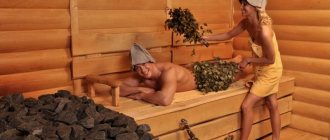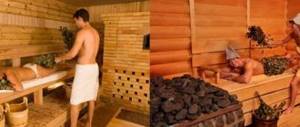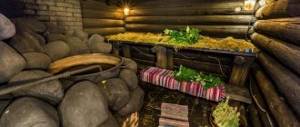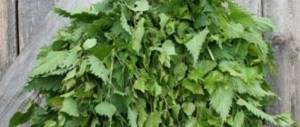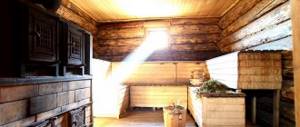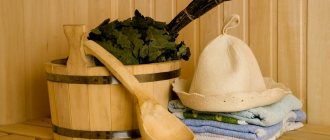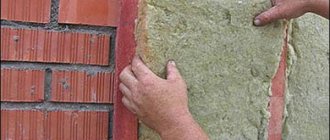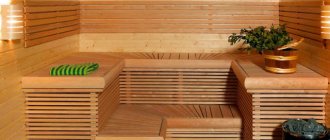If you believe the reference technical literature, then dry steam is a kind of steam-air substance heated to a temperature significantly higher than the boiling point of water at atmospheric pressure. Superheated steam can be obtained in special devices - steam superheaters. It has very high kinetic energy and its use radically increases the efficiency of steam engines.
And reference literature modestly indicates that dry superheated steam perfectly cleans surfaces of dirt and kills all living things, even microorganisms. Yes, we don’t need such steam, so we put aside technical literature and go to the Land of a Thousand Lakes, to Finland. Someone, namely the Finns, understand real and living dry steam like no one else.
Shadows of Forgotten Ancestors
The northern region, a country of forests and lakes, has long-standing bathhouse traditions. The Finns say that from time immemorial the first thing that appeared on a new site was a sauna. Babies were born there, the sick were nursed there, a family huddled within its walls while a residential building was being built.
The Finnish sauna tradition, like the vast majority of other peoples of the world, did not escape the so-called “smoky period”, a historical period when sauna stoves did not have a chimney and heated the steam room “in black”, directly with smoke and stove gases. Over time, smoke channels became an integral part of the sauna stove, which began to transfer its thermal energy to the stone backfill, which then heated the steam room, releasing accumulated heat into the space.
Everything seems to be the same as everywhere else. However, in Finland a characteristic distinctive feature has emerged - dry steam in the bathhouse. In order to understand its nature and features, it is necessary to consider the types of steam and the various properties of steam.
Flooding rules
Even before you start heating the bathhouse, it must be prepared. To obtain light steam, it is necessary to ventilate the room well so that it is free from dampness and mustiness. You can even heat it in advance so that the room can dry thoroughly.
It is also important to pay attention to the firewood , it must be dry. Birch and aspen are best suited. This wood will retain heat much longer than other wood. In addition, you need to take into account that the stones must be heated to a temperature of at least 350 °C; this is the type of bath that is considered correct.
The water supplied to the heater can be regular or flavored. It should be splashed moderately, otherwise a large release of hot air will occur. And this, in turn, will lead to a decrease in temperature. For safety reasons, do not stand very close to the heater, otherwise you may get burned.
To prepare steam, you must adhere to the following rules:
- To obtain a temperature of slightly more than 80 °C, the liquid should be splashed onto the walls, especially if these are herbal infusions. In this case, the healing substances will not burn on hot pebbles and will have a positive effect.
- If it is necessary to obtain a temperature below 80 °C, then water is applied directly to the stones, but they should first be cooled a little. This can be done using cold liquid, but you need to pour it in small quantities, otherwise there will be very little steam.
- Water must be served in small portions; the ideal dosage is 100 ml at a time. And already in the process it should be reduced to 50 ml.
In order for the steam to remain in the room for as long as possible, you should close the heater immediately after supplying liquid , which will ensure uniform heating. This applies to closed stoves. In open models, steam first goes to the ceiling and only then is distributed over the entire area.
There is strength in diversity
As is well known, the essence of bath procedures is the effect of elevated temperature on the human body. From the school physics course, everyone remembers perfectly well that air, in its pure form, without foreign impurities, is a poor conductor of heat. It was this property that the Chinese used at one time when they invented the thermos.
The situation changes dramatically if water vapor is present in the air. Its thermal conductivity increases dramatically. It has been scientifically proven that the most gentle, comfortable and predictable transfer of heat from the environment to the human body occurs when the content is 40-60 grams of water per 1 kg. air. At lower absolute humidity, to warm up the body, the temperature must be very high, which is fraught with heat stroke, with a water content of 70 g. in a cubic meter of air and above, uncomfortable conditions are created, associated primarily with waterlogging of the air, condensation of excess moisture and abnormal transfer of thermal energy to the human body.
What kind of steam should there be in a Russian bath?
Many can safely count themselves among those who like visiting the bathhouse, and there is a lot to love about it, not least for the steam in the bathhouse. It is thanks to him that warming procedures with a broom give such a beneficial effect. But is all steam so good, and how to prepare it correctly?
I think everyone has noticed that in some steam rooms it is very pleasant and comfortable, the heat in them is moderately dry and humid, distributed evenly, and does not burn, while in others it is heavy, as they say, ready to knock down the door in the steam room, and forces you to leave it as soon as possible . Where does this difference come from and what is the reason?
Differences between a bathhouse and a sauna
Quite often we do not differentiate between a bathhouse and a sauna, but these are completely different traditions and rules. Hence it turns out that after the completion of construction, it becomes unexpected for many that it is not possible to take a steam bath in the resulting building.
A traditional bath involves the so-called “broom steam”, where the temperature and humidity are in the closest ratios to each other: 50-60g and ow. 70-80% or 70-80g and ow. about 50%. In fact, it is often stated that the optimal ratio is 60x60. Many are inclined to argue that these are the indicators that are most useful for a Russian person. This is probably not unreasonable, because for many centuries people washed and steamed in just such a bathhouse.
The sauna came to us from Finland; its feature is the high temperature in the steam room with a low humidity coefficient. In such rooms equipped with sauna stoves, the air is often heated to very high levels - 90-100 degrees, the absence of high humidity allows you to feel good here. True, you can forget about procedures with a broom. Infrared radiation is useful only for warming up the body well. This feature is used as independent procedures or in preparation for a steam room with a broom.
It is clear that everyone has different tastes - some like the dry and hot atmosphere of a steam room, while others prefer a slightly lower temperature and more humidity. These fundamental points must be taken into account when choosing the type of material for the bathhouse itself and the appropriate stove model.
Taking into account different preferences, in cities and towns they do it very simply - in public institutions they set up two steam rooms: dry and wet. For many, including fans of wet steam, this turns out to be very convenient: before going to steam, they go into a dry steam room, warm up thoroughly, and then move to another with a broom.
It is not easy and very expensive to arrange two different steam rooms in your bathhouse, so you must initially make a choice in favor of one or the other.
Preparing traditional steam
In order for the famous phrase “enjoy your steam” to be appropriate, you need to take a lot into account. How good and comfortable you will feel in the steam room depends on many factors, but the main ones are the following - the design of the stove, a properly heated bathhouse and the water supply to the heater.
How do oven features affect steam?
Not all ovens are suitable for obtaining a moderately hot and humid atmosphere. Here are the most suitable ones:
- Brick. - Made of metal on wood. — Metal on natural gas.
It is better to give preference to iron stoves, which can be lined with brick or made of cast iron. All models of electric heaters, with some exceptions, are designed for saunas.
It is desirable that all of the above varieties have a closed heater. Why is that? In a nutshell, the steam from closed stoves is smooth and not burning, but from open stones it turns out to be scalding. The fact is that in open heaters the nature of steam formation is different: the surface layer of the stones quickly cools down, the steam on them does not have time to properly prepare, but immediately goes into the steam room, quickly overheating it. And after the first supply of water, a sharp release occurs, it is also called shock, but with the subsequent supply, the cooled stones simply do not have time to recover and it turns out wrong again.
In stoves with closed heaters, the entire mass of stones is heated evenly and maintains a high temperature for a long time, which allows you to take bath procedures for a long time without heating the stove.
Heat a sauna correctly
An entire article is devoted to this topic; you can read it here. In short, we can only say that an improperly prepared sauna can be not only unsuitable for a good time, but even dangerous to health (batch ovens).
Learning to throw water
Many modern types of devices are now capable of supplying water on their own; you just need to set them up in the right way, but this is sad. It turns out that the whole meaning of the ancient custom, which consists in two words - to create steam, is lost. Yes, this is exactly what they did before, and the more experienced the bathhouse attendant was, the more skillful he was. Here you need skill and prudence so as not to fill the stones and, again, to avoid excess dampness, then you can breathe easily.
1
This is how one expert on the Russian bath taught me:
- Look, don’t pour water into the heater, it’ll cool down. The steam will be wet and heavy. Add water little by little. Others think that steam is when your ears are blocked and you can’t breathe. And I will say this: the steam should be moderately dry and clear.
And yet, you need to be able to skillfully mix it into hot water before pouring it on stones, bread kvass or various herbal remedies. So that the steam room is filled with a fragrant and healing spirit.
In the old days, many subtle recipes for preparing steam were known and kept by those who truly knew bathhouse customs and knew how to steam with taste. Nowadays there is less and less desire to observe them and it is more difficult to follow them, but once you have tried them, you are unlikely to give them up.
You can get even more information on this topic from this video clip, and don’t let the unusual beginning confuse you, it will actually say a lot of useful things.
How to steam with a broom?
Before using a broom, you need to douse it with hot water if the broom is fresh, or steam it if the broom is dry. You need to steam the broom carefully so that the leaves do not fly off it and instead of a useful tool it does not turn into a golik with curls. To steam it, place it in a bowl of hot water (but not boiling water, as many people mistakenly do) and, covering it with another bowl or lid, leave for several minutes. A broom prepared in this way begins to exude aroma, and the branches from which it is made become more flexible. A broom is used to push hot air towards the body, creating waves that cover the body with heat. There is no need to hit the skin hard with a broom. It is enough just to lightly slap the leaves. Below you can watch a master class on steaming in a sauna:
Using a broom allows you not only to properly steam the skin to cleanse it of harmful substances, but also to saturate the body with phytoncides that prevent the development of diseases, and other useful substances - essential oils and microelements contained in the bark and leaves.
The benefits of bath steam for the body
The most effective way to cleanse the soul and body is actually hot steam. The benefits of saunas and steam baths are as follows:
- Has a calming effect. The sessions will help you cope with nervous tension.
- Visits help strengthen the immune system.
- The bath helps increase the number of red blood cells in the blood.
- It has an effect on the renewal of the body's physical strength.
- It has a beneficial effect in the treatment of colds.
- Helps harden the body during rapid temperature changes in the bathhouse.
- The steam helps eliminate waste, toxins and harmful substances from the body, as well as excess salt and fluid.
- Helps get rid of excess weight. It is in this effect that the secret of healing hot steam lies. The benefit of the bath is effective, harmless weight loss.
- When used correctly, it has a beneficial effect on the cardiovascular system. Sessions are especially important for hypotensive patients. With a rapid jump in temperature, the capillaries become more elastic, and at the same time the heart muscle strengthens.
- Hot steam is effective for respiratory diseases. The steam promotes the rapid removal of sputum. Visits are only possible if indicated by the attending physician.
- By regularly visiting the sauna you can get rid of painful sensations in the joints.
- The benefits of vapor are undeniable for the female half. Vapors are effective in cosmetology. They get rid of sweat, fats, toxins, and dirt. This has a good effect on the dermis, normalizes the shade, eliminates oily sheen and some types of pimples.
These are just the main positive aspects of visiting a sauna.
The third option is a Finnish sauna
Among other options, the Finnish sauna stands out. But it’s hard to immediately say what type of sauna it belongs to. After all, the regimes of dry and wet steam alternate there. First, you are in a room with low air humidity and breathe dry steam, after that you pour water on the heater and breathe in wet steam. Then the moisture evaporates, and at the end you need to breathe dry steam again. This option of alternating air is offered by many saunas in Moscow.
You will need to repeat similar procedures in a Finnish sauna 3 to 4 times. And in such a sauna, brooms are an indispensable attribute. Since the temperature there can reach 140-150 degrees, beginners are not recommended to visit Finnish saunas the first time.
Thus, it is difficult to immediately say which sauna option is better. Indeed, in this case you need to be guided purely by your personal feelings.
